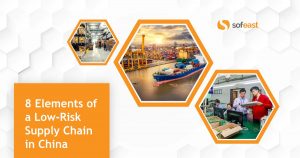I am getting tired of reading “expert commentaries” about the impact of the Covid-19 epidemic on supply chains. They all seem to say the same thing, and (in my mind) they tend to overlook certain facts.
Let’s look at 4 commonly held truths that I disagree with.
First truth: “the current epidemic is a ‘black swan’ event”
This image was popularized by Nassim Nicolas Taleb. I have read all his books since ‘Fooled by Randomness’ and I really liked them. To keep things simple, a ‘Black Swan‘ is an event that financial models (or, more widely, predictions about the future) deem so unlikely they don’t need to be taken into account… until they do happen!
When a Fortune 500 company that spent significant time on strategic planning invokes the ‘black swan’ image, I have to question their abilities, though.
People like Bill Gates, who really try to understand what will happen in the decades to come (not in the next quarter), have been thinking of such an event. Last week, Gates wrote:
Global health experts have been saying for years that another pandemic rivalling the speed and severity of the 1918 influenza epidemic wasn’t a matter of if but when. The Bill & Melinda Gates Foundation has committed significant resources in recent years to helping the world prepare for such a scenario.
Now, in addition to the perennial challenge, we face an immediate crisis. In the past week, COVID-19 has started to behave a lot like the once-in-a-century pathogen we’ve been worried about. I hope it’s not that bad, but we should assume that it will be until we know otherwise.
And it’s not like long supply chains haven’t been hit recently. SARS in 2003. The Japan tsunami + Fukushima disaster, and also the Thai floods, in 2011. Insufficient warning??
So, if your 200-people supplier says they had not even considered it in their business continuity plan, fine. When major corporations and institutions say that, I guess some board members need to get pushed out…
[UPDATE 11 April: Nasim Taleb confirmed this epidemic is NOT a Black Swan in this video.]
Second truth:” the ideal supply chain is resilient”
I searched the meaning of the word resilient: “able to recoil or spring back into shape after bending, stretching, or being compressed”. In other words, when there is a hit, the ideal situation would be to take the hit and then get back to normal quickly.
Now, to borrow again from a book written by Taleb (Antifragile), the ideal supply chain would be robust (“able to withstand or overcome adverse conditions”). Don’t even take a hit! Isn’t that better??
How to do this? I cover it in the next sections.
Third truth: the ‘just in time’ inventory management, and the lean approach in general, are responsible for all these material shortages
So wrong. Long supply chains (spanning several countries) are absolutely not lean, to begin with…
Mark Graban just debunked this idea nicely in Covid-19: Don’t Blame Toyota or “Just in Time” for Your Risky Supply Chain Strategy:
Yes, many factories have been shut down in China, which disrupts global supply chains. However, if you’re a company that decided to move all of your production to China (to then ship out to customers around the world), that wasn’t a “Lean” strategy.
It’s really difficult to support “just in time” delivery over such long distances. If it were a “Lean” approach to move all of your production to China, then Toyota would have done that. But, Toyota didn’t.
Toyota has increasingly built assembly capacity around the world to be CLOSER to their customers.
There you go. If your suppliers are close to your assembly factory, which is close to your end customers, you don’t even take a hit when all of China gets locked down.
Fourth truth: buying one key component from only one supplier is a bad idea
Most people hold it as self-evident that every key component has to be made by at least 2 suppliers.
This is firmly embedded in the classic transactional approach: don’t tell your suppliers too much, keep them off-balance, pressure their costs… And all this leads to working with second-rate manufacturers that invest little in R&D and don’t try to help you!
I was reading another article on the topic of We Need More Resilient Supply Chains, and it made the following point:
Many companies are probably also regretting their reliance on a single company for items they directly purchase. Supply-chain managers know the risks of single sourcing, but they do it anyway in order to secure their supply or meet a cost target. Often, they have limited options to choose from, and increasingly those options are only in China.
The authors make good suggestions, though. Here are some measures that make sense when buying components for which (1) supply disruption is relatively likely and (2) the impact on revenue would be high:
- Know where parts are made and stored and know the sub-suppliers (including where their operations are located)
- Develop an alternate supplier, and/or ask the sole supplier to develop an alternate source (where their own suppliers manufacture, and where they manufacture)
- If your direct supplier is very reliable, have them do a risk analysis, develop alternate sources, etc.
- Buy insurance to cover the risk of supply interruption
Yes! Finally! Someone understands that a good supplier can be trusted to organize a backup by themselves. This is particularly applicable when you rely on a true partner that has proven their value developing your new products or re-engineering your current products.
If your suppliers have already diversified their own sourcing & manufacturing locations, or keep a strategic stock of certain parts, again, you may not even take a big hit when China shuts down.
What do you think? Do you agree these 4 commonly-accepted truths often miss the mark? Have you come across similar misconceptions?
8 Elements of a Low-Risk Supply Chain in China
This FREE webinar will empower you to transform your supply chain in China to reduce risks. I and Paul Adams, a senior engineer from Sofeast, talk you through how to gain control over your product’s quality, on-time shipments, long-term pricing stability, and continuity of supply.
Ready to watch? Register by hitting the button below:



Interesting piece. We disagree with several items. Can we have permission to reprint in CERM Risk Insights. We will provide proper attribution.
Sure! Looking forward to reading what you disagree with. 🙂